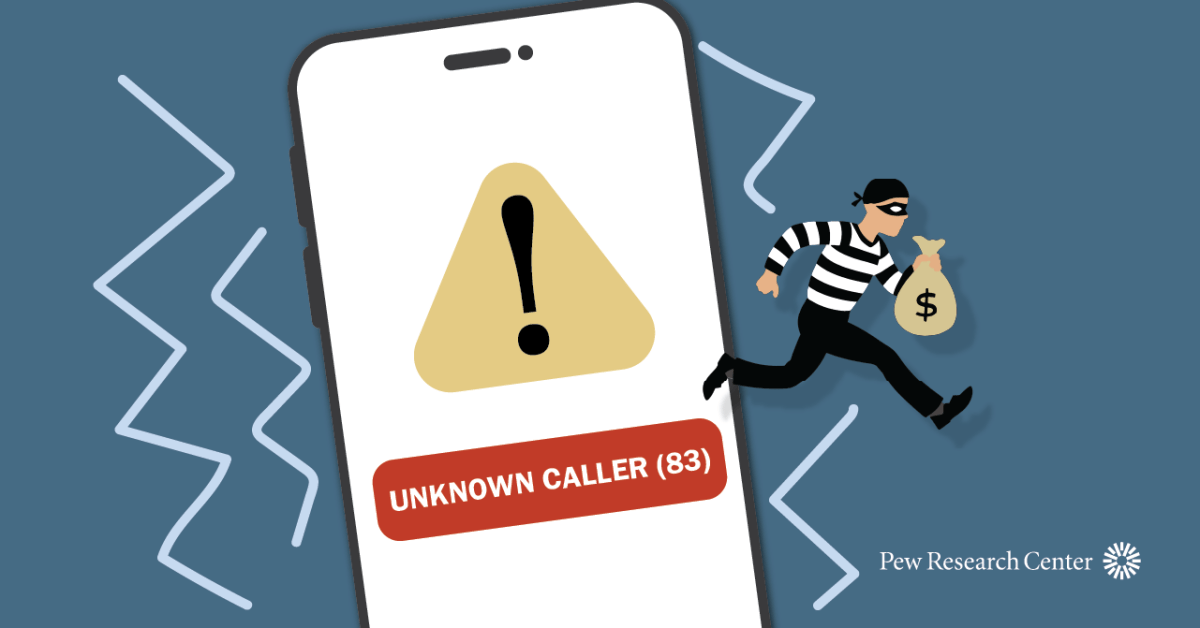Online scams and other internet crimes are skyrocketing, with a record $16.6 billion in losses reported to the FBI in 2024. The federal government, banks and companies are all sounding alarms. And the public is also wary, with many having firsthand experience:
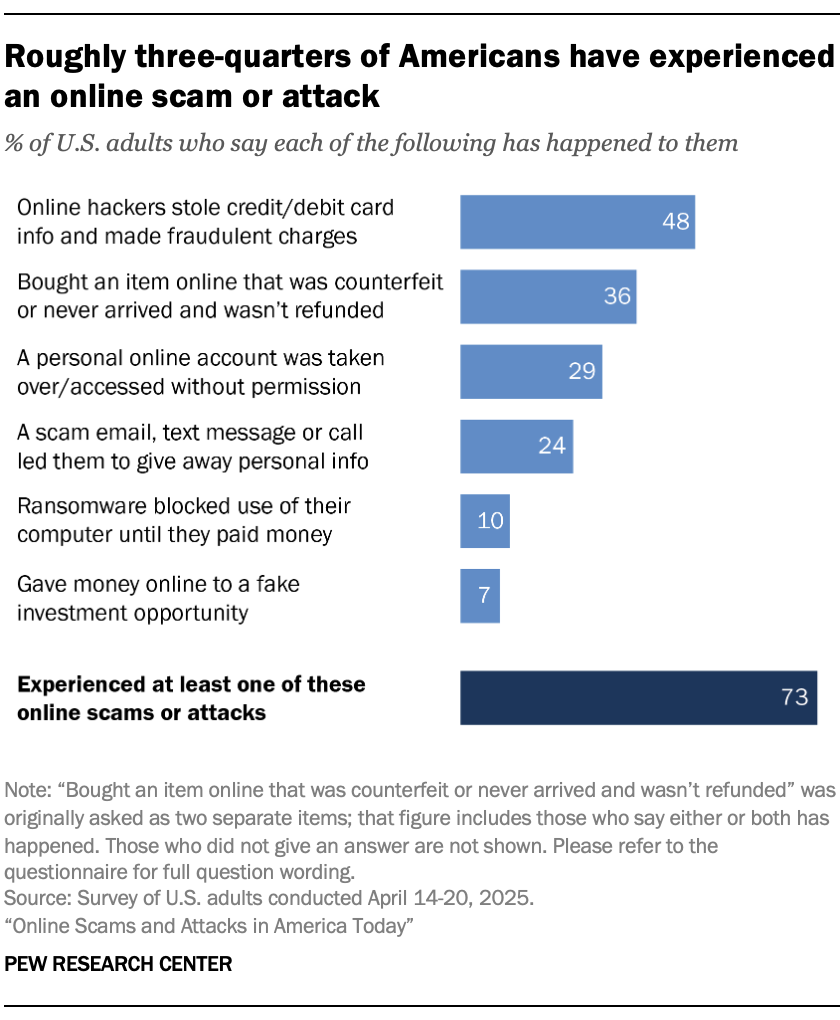
- Nearly all Americans view online scams and attacks as a national problem. More than nine-in-ten say online scams and attacks are a problem in the country, including 79% who describe them as a major problem.
- Most U.S. adults have been a victim of an online scam or attack. We find that 73% of U.S. adults have ever experienced things like credit card fraud, ransomware or online shopping scams.
While Americans see older adults as more vulnerable to these crimes, significant portions of both older and younger adults have been scammed and targeted online. These are some of the key findings from a Pew Research Center survey of 9,397 U.S. adults conducted from April 14 to 20, 2025.
We asked Americans if six different types of online scams or attacks had happened to them. Overall, about three-quarters (73%) say at least one has, with 32% saying it’s happened in the past year.
Of the six, Americans most commonly report that online hackers made fraudulent charges on their credit or debit card. About half of U.S. adults (48%) report this has happened to them.
Roughly a quarter to a third report that three other types of scams happened to them:
- 36% say they purchased an item online that never arrived or was counterfeit and it was not refunded.
- 29% say a personal online account was hacked, such as a social media, email or bank account.
- 24% say they got a scam email, text message or call that led them to give away personal information.
One-in-ten or fewer say the remaining two scams and online attacks happened:
- 10% say that ransomware blocked use of their computer until they paid money.
- 7% say they gave money to a fake online investment opportunity, such as for real estate or stocks.
Many Americans have had multiple types of online scams happen to them. About one-in-five (22%) say they’ve experienced two of six, and the same share say three or more.
By age
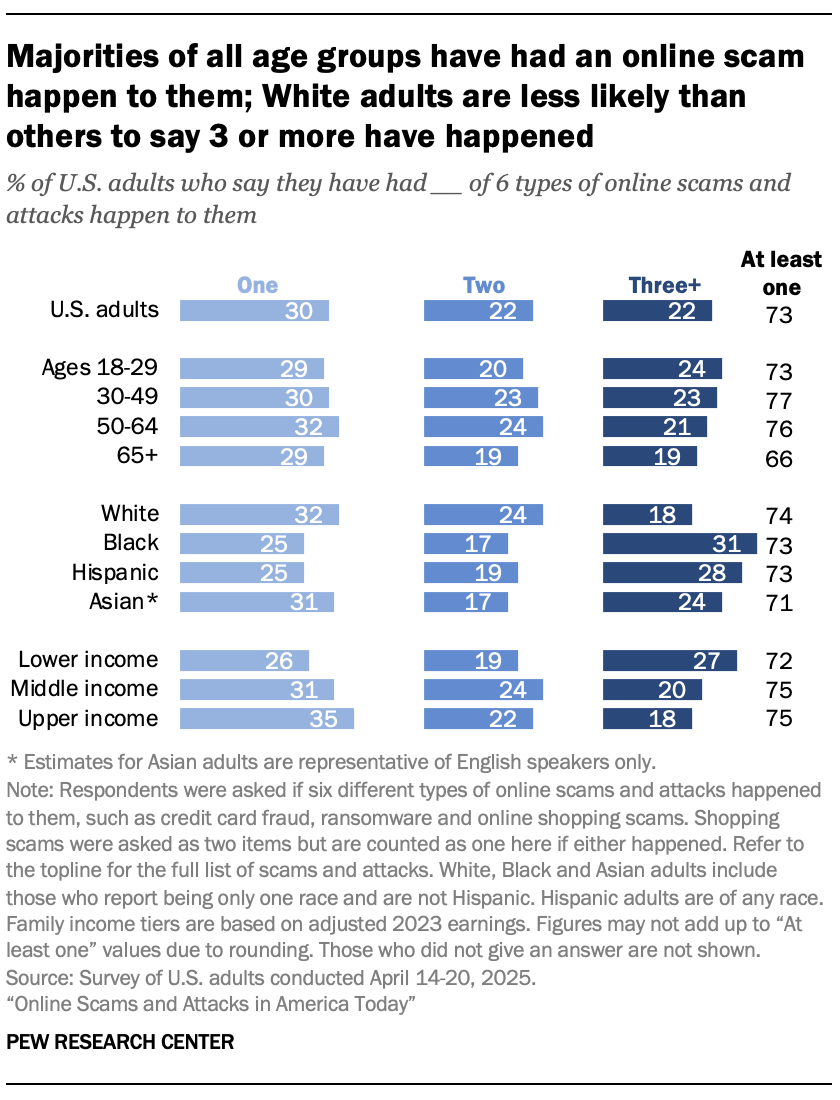
Large portions of both older and younger adults report that scams and online attacks have happened to them.
About three-quarters of adults under 30, as well as those ages 30 to 49 and 50 to 64, report ever experiencing an online scam or attack. A slightly smaller share of those 65 and older (66%) report the same.
Additionally, experiencing multiple types of scams or attacks is roughly on par across age groups.
By race and ethnicity
While there are no differences between racial and ethnic groups in experiencing at least one of the scams or attacks, Black, Hispanic and Asian adults are more likely than White adults to have had multiple forms of these frauds happen to them.
For example, about three-in-ten Black or Hispanic adults have faced three or more types of online scams or attacks, compared with 18% of White adults.
By income
Americans in households across income levels are about as likely to say they’ve ever experienced at least one of the online scams. But those in households with lower incomes are more likely to say at least three have happened.
Go to the Appendix for a demographic breakdown of each of the six scams and online attacks.
Scam messages
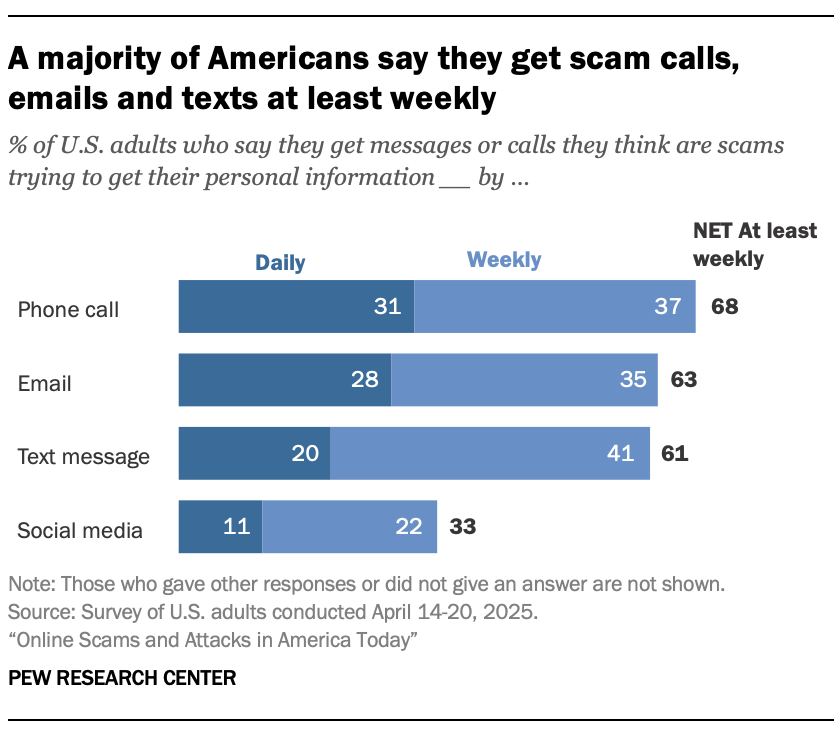
Online scams target Americans in variety of ways, including phone calls, texts and emails. According to our survey, a majority of U.S. adults report getting scam phone calls (68%), emails (63%) or text messages (61%) at least weekly that attempt to get their personal information. One-third get these messages on social media at the same frequency.
These attempts to get personal information aren’t just a weekly occurrence; for some, they’re a daily reality.
- 31% say they get scam phone calls at least daily, including 21% who say this happens several times a day.
- 28% say they get daily scam emails.
- 20% encounter this by text message on a daily basis.
- Fewer (11%) say the same for social media.
Go to the Appendix for the demographic breakdown of those who have experienced scam messages in each way.
Financial losses and impact on financial well-being
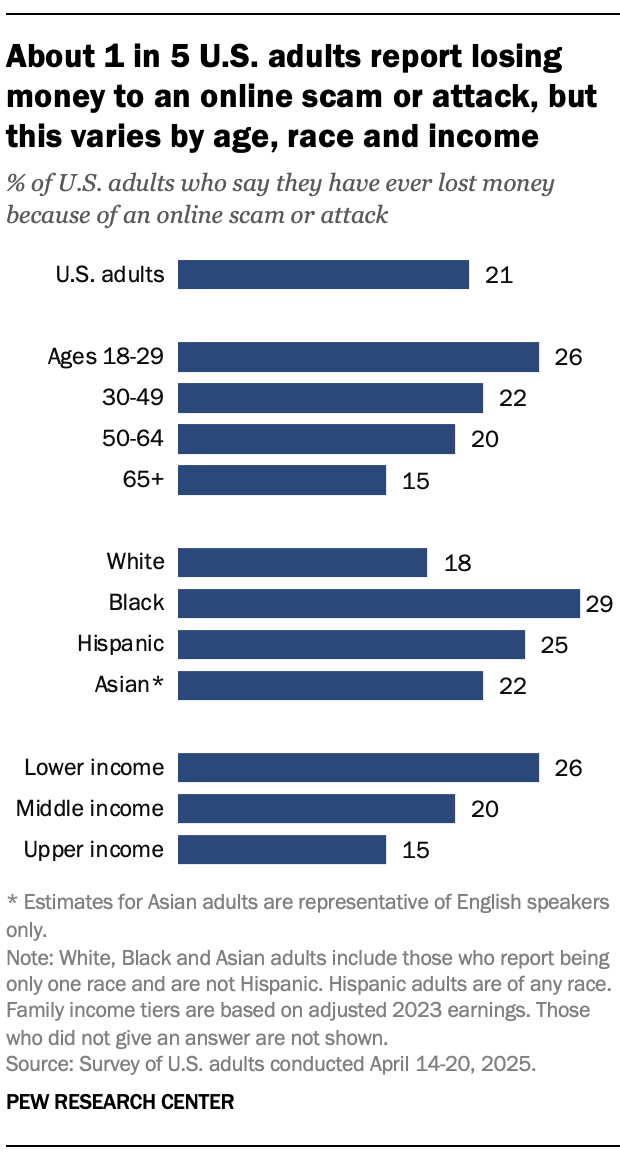
More money is being lost to online scams and cybercriminals than ever before, according to the FBI.
In our survey, roughly one-in-five U.S. adults (21%) say they have ever lost money because of an online scam or attack.
By age
Younger Americans are slightly more likely than their older counterparts to say they have lost money because of an online scam or attack.
About a quarter of 18- to 29-year-olds say they’ve lost money in this way, compared with 15% of those 65 and older.
By race and ethnicity
There are also differences by race and ethnicity. Black, Hispanic and Asian adults are more likely than White adults to say they have lost money because of an online scam or attack.
By household income
Those with lower incomes (26%) are more likely than those in upper-income households (15%) to say they have lost money in this way. Those in middle-income households fall in between the two other groups (20%).
Financial impact
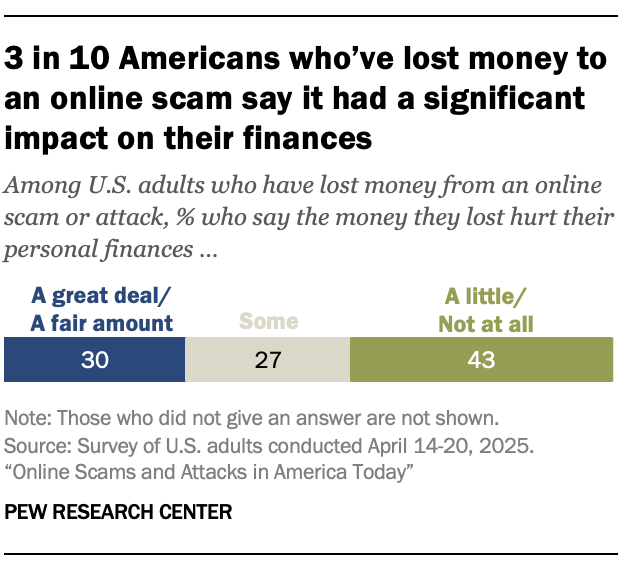
For some, losing money in an online scam was financially burdensome. Among those who’ve lost money because of an online scam or attack:
- 30% say it hurt their personal finances a great deal (11%) or a fair amount (19%).
- Another 27% said it hurt their finances to some extent.
- But about four-in-ten said this had little (31%) to no harm (11%) on them financially.
Contacting law enforcement
Most people who’ve been a financial victim to an online scam or attack never contacted the authorities.
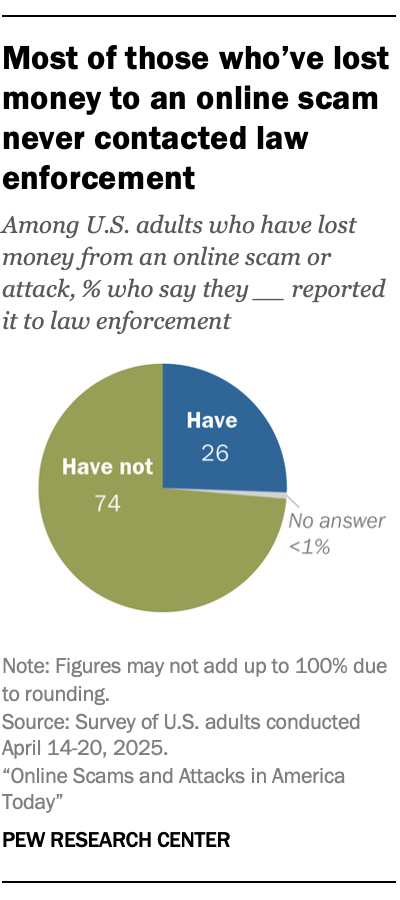
Roughly three-quarters of this group say they have not reported to law enforcement that they lost money from an online scam or attack. A minority of this group – 26% – say they have informed law enforcement.
By how much it hurt personal finances
Americans who have been significantly harmed financially by an online scam are far more likely to say they informed law enforcement:
- 42% of those whose finances were hurt a great deal or fair amount reported it.
- Fewer (24%) of those whose finances were hurt some say they did the same.
- And just 16% of those whose finances were hurt a little or not at all say they reported it.
Vulnerability to online scams and attacks
Amid debates about which age groups are most vulnerable to online scams, Americans show greater concern for older adults.
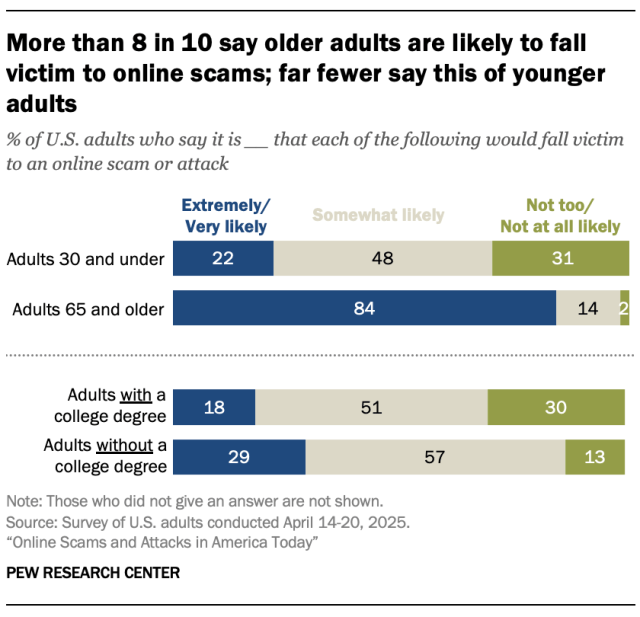
A vast majority of Americans (84%) say adults 65 and older are extremely or very likely to fall victim to online scams and attacks.
This is far higher than the 22% who say this of adults 30 and under. An additional 48% say it is somewhat likely to happen to this age group.
Americans do not see education as a big factor in whether someone will fall for an online scam. But a somewhat greater share of U.S. adults say those with lower levels of formal education are vulnerable:
- 29% say those without a four-year college degree are extremely or very likely to fall victim.
- 18% say the same of those who have a four-year degree.
- For both, Americans most commonly say this is somewhat likely to happen.
By age
Large shares of all age groups say older adults are vulnerable to online scams. About eight-in-ten adults under 30 (82%) – and the same share of those 65 and older – say those 65 and up are extremely or very likely to have this happen to them.
Older Americans are more likely than the youngest adults to say adults 30 and under are vulnerable. Just 15% of 18- to 29-year-olds say adults 30 and under are highly likely to fall for one. This is lower than the 27% of those 65 and older and 25% of those 50 to 64 who say this.
Knowing how to avoid falling for an online scam
When it comes to their own vulnerability, Americans overall feel they are quite knowledgeable in how to detect online scams and attacks.
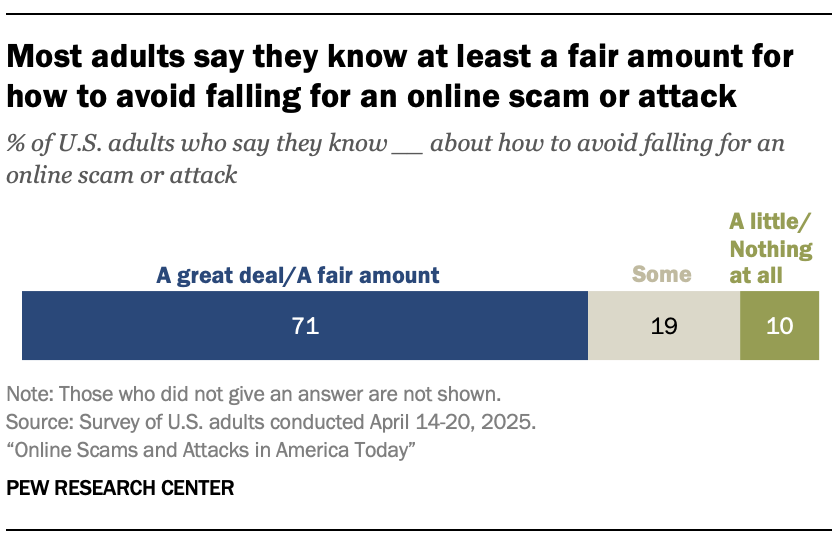
Most Americans (71%) say they know at least a fair amount about how to avoid falling for an online scam or attack. This includes 26% who say they know a great deal.
Very few (10%) report knowing little to nothing, and about one-in-five say they know some.
By age
Majorities across age groups say they know at least a fair amount about how to avoid falling for an online scam or attack, but older Americans are less likely to say this. For example, Americans ages 65 and older are less likely than 18- to 29-year-olds to say this (64% vs. 78%).
By race and ethnicity
Three-quarters of White adults say they know a great deal or fair amount about how to avoid falling for one. This is higher than among Hispanic (59%), Black (66%) and Asian (66%) adults.
Americans’ concern about online scams
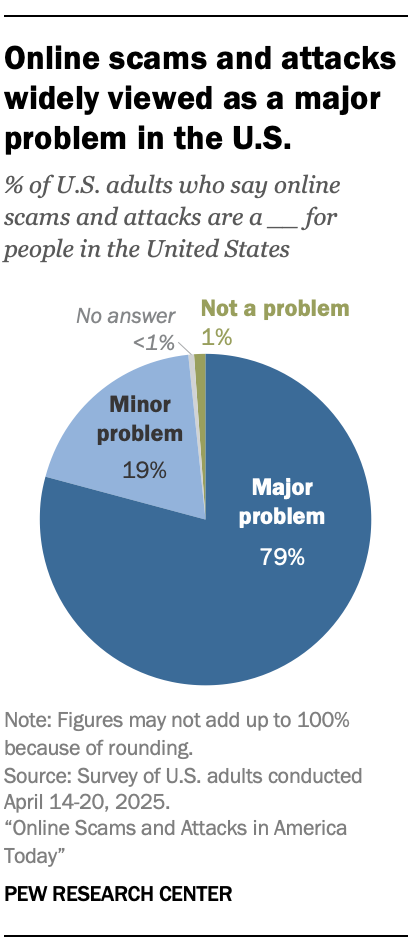
Nearly all Americans say online scams and attacks are a problem for people in the United States. This includes about eight-in-ten who say they are a major problem and 19% who say they are a minor problem.
Only 1% say online scams and attacks are not a problem for people in the U.S.
By age
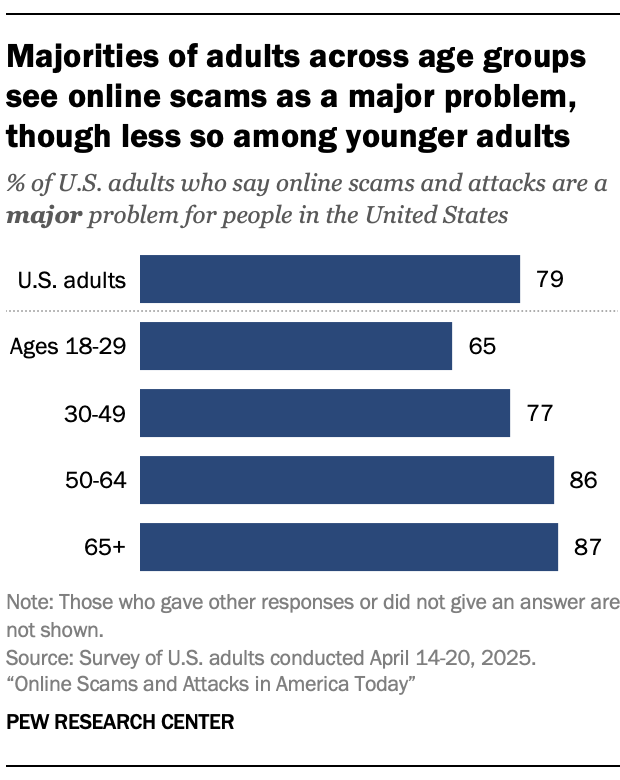
Younger adults are less likely to say online scams are a big issue, though majorities of all age groups say this. About two-thirds of those ages 18 to 29 (65%) say online scams are a major problem. This compares with nearly nine-in-ten of 50- to 64-year-olds and those 65 and older.
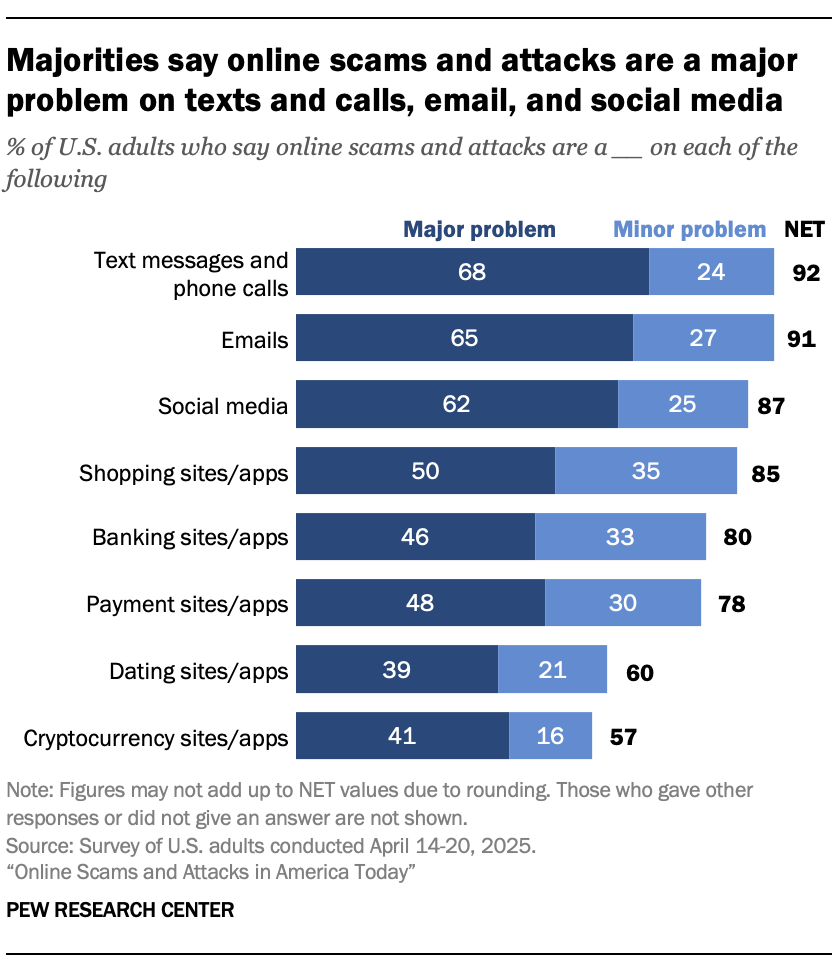
Online fraud spans many digital spaces, but the public sees some environments as more of an issue for fraud than others.
We asked Americans about eight different types of platforms. About six-in-ten or more say online scams are a major problem on text messages and phone calls, emails and social media. And about a quarter more also say each is a minor problem.
Americans are less likely to say online scams are a major problem on the other types of platforms asked about:
- Between 46% and 50% say this of online shopping, banking and payment sites and apps.
- About four-in-ten say this of dating or cryptocurrency platforms.
Go to the Appendix for the demographic breakdown of views about whether online scams are a problem on each type of platform.
The role of artificial intelligence in online scams and attacks
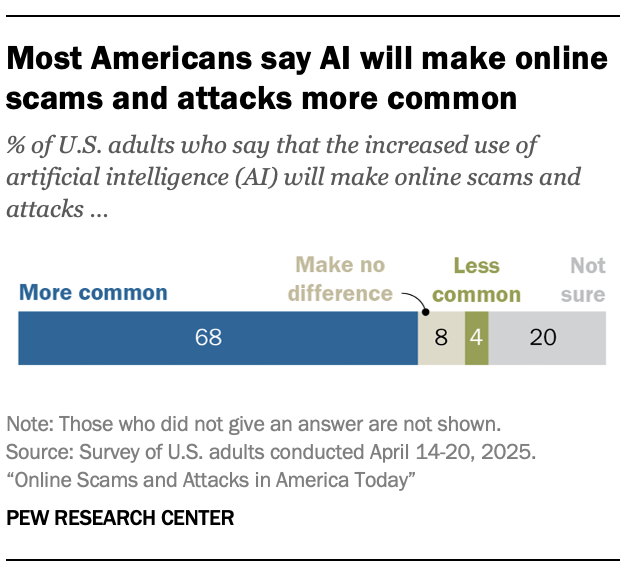
Americans are becoming more familiar with artificial intelligence (AI) while also growing more concerned about its impact on daily life. When it comes to online scams and attacks, most Americans say AI will make them more frequent.
In fact, about seven-in-ten (68%) say the increased use of AI is going to make online scams and attacks more common. Very few say AI will make them less common (4%) or will make no difference (8%). The remaining 20% are unsure.
Government and tech companies’ efforts in reducing online scams and attacks
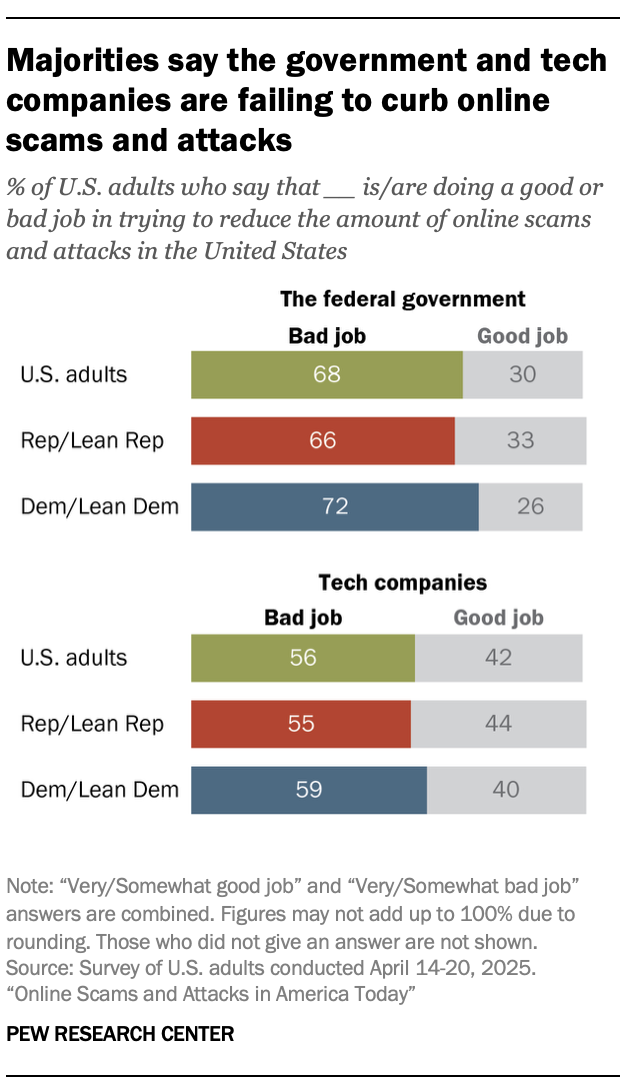
From awareness campaigns to legislation to AI, the federal government and technology companies use a number of tactics to combat online fraud.
The survey asked Americans to rate how each group is faring at reducing the number of online scams and attacks in the U.S. Americans on balance see both more negatively than positively – especially the government:
- 68% say the federal government is doing a very or somewhat bad job; three-in-ten say it’s doing a good job.
- 56% say technology companies are doing a bad job at this, versus 42% who express a favorable view of their efforts.
By party
Majorities of both Republicans (66%) and Democrats (72%), including independents who lean to either party, say the federal government is doing a very or somewhat bad job at reducing the amount of online scams and attacks.
Republicans and Democrats also share similar views on the job that technology companies are doing. More than half in each group say these companies are not doing well in reducing online scams and attacks in this country. In both cases, Democrats are slightly more likely than Republicans to say this.
